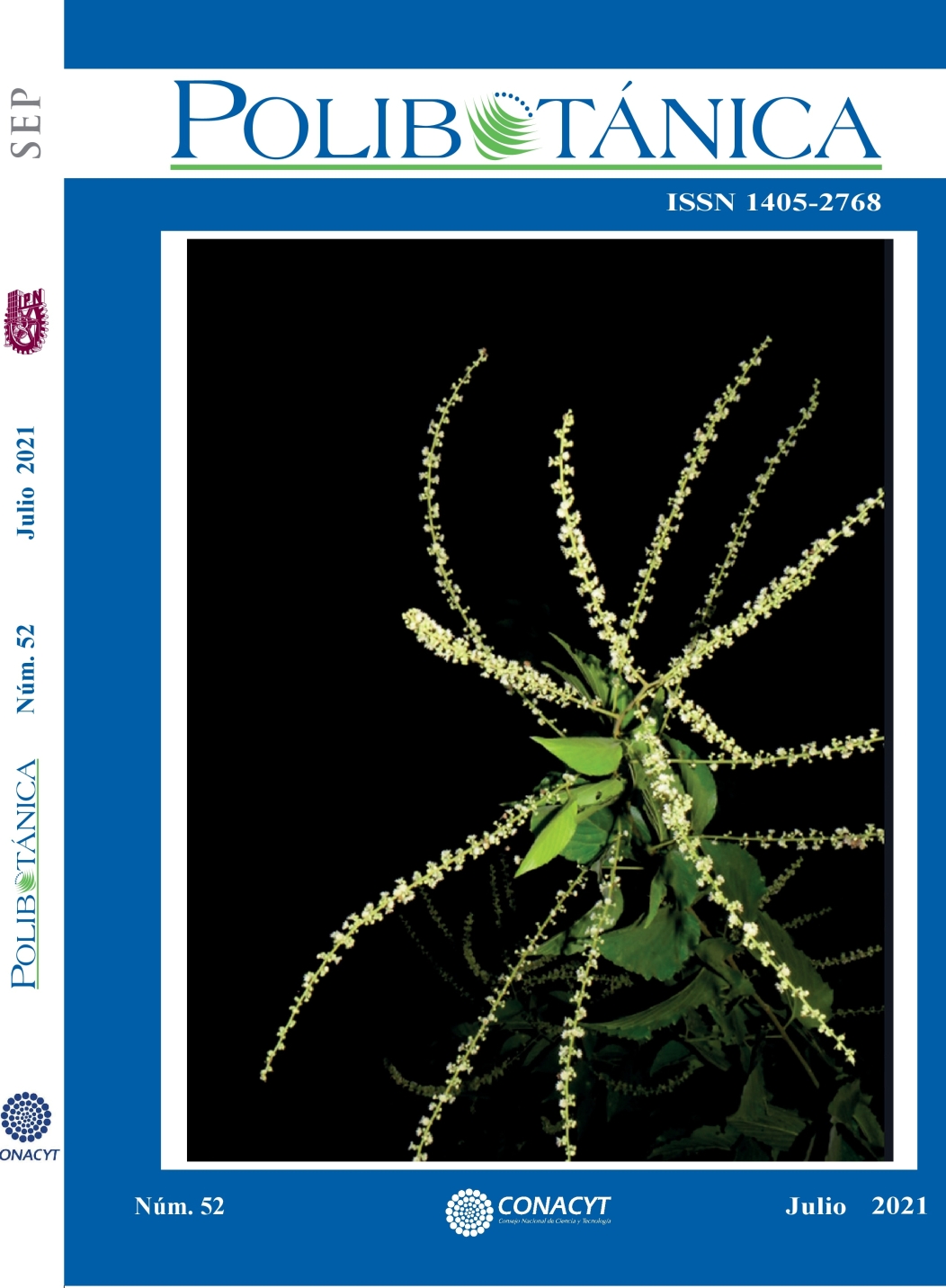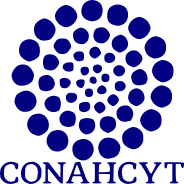Structure and diversity of the tamaulipan thornscrub regenerated after use for livestock
DOI:
https://doi.org/10.18387/polibotanica.52.6Keywords:
Havardia pallens, Vachellia farnesiana, Zanthoxylum fagaraAbstract
In recent years, the structure of the Tamaulipas thornscrub has been studied after having undergone some anthropogenic activity, but little research has addressed the issue of phylogeny. In the present study, the objective was to evaluate the composition, structure and diversity of a regenerated plant community after a livestock use with 36 years of regeneration. Furthermore, it is evaluated whether the phylogenetic distance between individuals correlated with the physical distance. The most closely related individuals are expected to be further removed from one another as a strategy of lessening competition. Four 40m x 40m plots were established. To each individual> 1 cm of d.a.p. The total height, basal diameter and crown diameter were measured in a north-south and east-west direction. For the phylogenetic analysis, of Havardia pallens, Vachellia farnesiana and Zantozylum fagara was chosen as the star species and the physical distance in cm with its five closest neighbors was measured. The phylogenetic distance was estimated using Time Tree, between the star species and its five closest neighbors. 15 species were recorded. The Fabaceae and Rutaceae families represent 77.52% of the Family Importance Value Index. Vachellia farnesiana, Havardia pallens and Zanthoxylum fagara were the species with the highest Importance Value Index. The Pretzsch index was an A of 2.36, Amax of 3.81 and Arel of 62.08%. The correlation between the years from a common ancestor with the physical distance of the closest neighbors for Havardia pallens and Vachellia farnesiana was not detected. For Zanthoxylum fagara, there was a negative correlation (-0.64) between physical distance and years from a common ancestor with its closest neighbors.
References
Aguirre A. y Mendoza R. et al. 2009. (2009). Especies exóticas invasoras: impactos sobre las poblaciones de flora y fauna, los procesos ecológicos y la economía. In CONABIO (Ed.), Capital natural de México (Capital na, pp. 277–318).
Alanís, E., Alanís, E., Jiménez, J., Jiménez, J., Aguirre, O., Aguirre, O., Treviño, E., Treviño, E., Jurado, E., Jurado, E., González, M., & González, M. (2008). Efecto del uso del suelo en la fitodiversidad del matorral espinoso tamaulipeco. Ciencia UANL, XI(1), 56–62.
Alanís Rodríguez, E., Jiménez Pérez, J., González Tagle, M. G., Yerena Yamallel, J. Y., Cuellar Rodríguez, G., & Mora-Olivo, A. (2013). Análisis de la vegetación secundaria del matorral espinoso tamaulipeco, méxico. Phyton, 82(December), 185–191.
Armienta M.A., Ongley L.K., Rodríguez R., Cruz O., M. H. y V. G. (2008). Arsenic distribution in mesquite (Prosopis laevigata) and huizache (Acacia farnesiana) in the Zimapán mining area, México. Geochemistry: Exploration, Environment, Analysis, 8, 1–7. https://doi.org/https://doi.org/10.1144/1467-7873/07-144
Baev, P.V. y Penev, L. D. . (1995). BIODIV: program for calculating biological diversity parameters, similarity, niche overlap, and cluster analysis. (5.1.; p. 57). Pensoft, Sofia-Moscow.
Boucher, D., James, S., & Keeler, K. H. (1982). THE ECOLOGY OF.
Brooker, R. W., Maestre, F. T., Callaway, R. M., Lortie, C. L., Cavieres, L. A., Kunstler, G., Liancourt, P., Tielbörger, K., Travis, J. M. J., Anthelme, F., Armas, C., Coll, L., Corcket, E., Delzon, S., Forey, E., Kikvidze, Z., Olofsson, J., Pugnaire, F., Quiroz, C. L., … Michalet, R. (2008). Facilitation in plant communities: The past, the present, and the future. Journal of Ecology, 96(1), 18–34. https://doi.org/10.1111/j.1365-2745.2007.01295.x
Cantú Silva, I., & Yañez Díaz, M. I. (2018). Efecto del cambio de uso de suelo en el contenido del carbono orgánico y nitrógeno del suelo. Revista Mexicana de Ciencias Forestales, 9(45), 122–151. https://doi.org/10.29298/rmcf.v9i45.138
Eduardo Estrada; Yen MÉNDEZ, Carmen; Delgado SALINAS, Alfonso; Villarreal QUINTANILLA, J. A. (2004). Legumiosas del centro del estado de Nuevo León, México. Anales Del Instituto de Biología. Serie Botánica, 75(1). http://www.redalyc.org/html/400/40075105/
Espinosa, J. V. y F. (1998). Catálogo de malezas de México (Universidad Nacional Autónoma de México. Consejo Nacional Consultivo Fitosanitario. Fondo de Cultura Económica (ed.)).
Godoy, O., N. Kraft, and J. L. (2014). Phylogenetic relatedness and the determinants of competitive outcomes. Ecol. Lett, 17, 836–844. https://doi.org/https://doi.org/10.1111/ele.12289
González, M. (1985). El límite sur de la provincia biótica tamaulipeca.
Hedges S, Dudley J, K. S. 2006. T. (2006). TimeTree: a public knowledge-base of divergence times among organisms. Bioinformatics, 22(23), 2971–2972.
Humberto Gónzalez-Rodríguez, Israel Cantú-Silva, M. V. G. M. y J. I. U. S. (2010). Composición y estructura de la vegetación en tres sitios de estudio del estado de Nuevo, León, México. Polibotánica, 29, 91–106.
Instituto Nacional de Estadística y Geografía. (1986). Síntesis geográfica de Nuevo León (Secretaria de Programación y Presupuesto (ed.)).
Jiménez Pérez, J., Alanís Rodríguez, E., Ruiz González, J., González Tagle, M., Yerena Yamallel, J., & Alanís Flores, G. (2012). Diversidad de la regeneración leñosa del matorral espinoso tamaulipeco con historial agrícola en el noreste de México. Ciencia-Uanl, 15(58), 66–71.
Jost, L. (2006). Entropy and di v ersity. 2.
Leal Elizondo, N. A., Alanís Rodríguez, E., Mata Balderas, J. M., Treviño Garza, E. J., & Yerena Yamallel, J. I. (2018). Estructura Y Diversidad De Especies Leñosas Del Matorral Espinoso Tamaulipeco Regenerado Post-Ganadería En El Noreste De México. Structure and Diversity of Tamaulipanthornscrub Regenerated After Livestock in Northeast Mexico. Polibotánica, 0(45), 75–88. https://doi.org/10.18387/polibotanica.45.6
Magurran, A. (1988). Ecological Diversity and its Measurement.
Marroquín, J., Jurado, E., Flores, J., Pando-Moreno, M., González-Rodríguez, H., & Alanís, E. (2019). Are plants nearest neighbors phylogenetically distant? A test in three vegetation types in Northern Mexico1,2. The Journal of the Torrey Botanical Society, 146(1), 41. https://doi.org/10.3159/torrey-d-17-00050.1
McKey, D. (1994). Legumes and nitrogen: The evolutionary ecology of a nitrogen-demanding lifestyle. Advances in Legume Systematics 5: The Nitrogen Factor, 5(JANUARY 1994), 211–228. https://doi.org/10.1007/s13398-014-0173-7.2
Molina-Guerra, V. M., Pando-Moreno, M., Alanís-Rodríguez, E., Canizales-Velázquez, P. A., Rodríguez, H. G., & Jiménez-Pérez, J. (2013). Composición y diversidad vegetal de dos sistemas de pastoreo en el matorral espinoso tamaulipeco del Noreste de México. Revista Mexicana De Ciencias Pecuarias, 4(3), 361–371.
Mora, C., Rodríguez, E., Pérez, J., González, M., Yerena, J., & Cuellar, L. (2013). Estructura, composición florística y diversidad del matorral espinoso tamaulipeco, México. Ecología Aplicada, 12(1), 29–34. http://www.scielo.org.pe/scielo.php?pid=S1726-22162013000100004&script=sci_arttext
Moreno, C. (2001). Métodos para medir la biodiversidad. (M.-M. y T. SEA. (ed.); Vol. 1).
Mueller-dombois, D. (2014). Aims and methods of vegetation ecology. August 1974.
O. Landeros Tejo, R., Reveles, M., Valdez, R.D., Arreola, J.G., Pedroza A. y Ruíz, J. (2012). Uso potencial del huizache (Acacia farnesiana L. Will) en la fotorremediación de suelos contaminados con plomo. Rev. Chapingo Serie Ciencias Forestales y Del Ambiente, 17, 11–20.
Penone, C., Davidson, A. D., Shoemaker, K. T., Di Marco, M., Rondinini, C., Brooks, T. M., Young, B. E., Graham, C. H., & Costa, G. C. (2014). Imputation of missing data in life-history trait datasets: Which approach performs the best? Methods in Ecology and Evolution, 5(9), 961–970. https://doi.org/10.1111/2041-210X.12232
Pequeño-Ledezma, M. Á., Alanís-Rodríguez, E., Jiménez-Pérez, J., González-Tagle, M. A., Yerena-Yamallel, J. I., Cuellar-Rodríguez, G., & Mora-Olivo, A. (2012). Análisis de la restauración pasiva post-pecuaria en el matorral espinoso tamaulipeco del noreste de México. CienciaUAT, 7(1), 48. https://doi.org/10.29059/cienciauat.v7i1.39
Pretzsch, H. (2009). Forest Dynamics, Growth and Yield. From Measurement to Model (Springer-Verlag (ed.)).
Quero Carrillo, A. R. (2013). Gramíneas Introducidas: Importancia e impacto en ecosistemas ganaderos.
Rojas-Mendoza, P. (1965). Generalidades sobre la vegetación del estado de Nuevo León y datos acerca de su flora. Universidad Nacional Autónoma de México, México, D.F.
Rzedowski, J. (1978). Vegetación de México (Limusa (ed.)).
SEMARNAT. (2006). El Medio Ambiente en México 2005: en resumen.
Stachowicz, J. J. (2016). the Structure of Ecological Communities. 3568(April). https://doi.org/10.1641/0006-3568(2001)051
Valiente-Banuet, A., & Verdú, M. (2007). Facilitation can increase the phylogenetic diversity of plant communities. Ecology Letters, 10(11), 1029–1036. https://doi.org/10.1111/j.1461-0248.2007.01100.x
Vívictor Manuel Molina-Guerra, Arturo Mora-Olivo, Eduardo Alanís-Rodríguez, Brianda Elizabeth Soto-Mata, A. M. P.-F. (2019). Plantas caracteristicas del matorral espinoso tamaulipeco en México (Editorial Universitaria de la Universidad Autónoma de Nuevo León (ed.)).
Villarreal, O. L. B. y J. (2001). egetación y flora de un ecotono entre las provincias del Altiplano y de la Planicie Costera del Noreste de Méxic. Acta Botanica Mexicana, 55, 39–67.
Violle C, Nemergut D, Pu Z, J. L. (2011). Phylogenetic limiting similarity and competitive exclusion. Ecol. Lett, 14, 728–787. https://doi.org/https://doi.org/10.1111/j.1461-0248.2011.01644.x
Whittaker, R. (1972). Evolution and measurement of species diversity. Taxon, 21, 213–251.
Downloads
Published
Issue
Section
License

Polibotánica by Departamento de Botánica de la Escuela Nacional de Ciencias Biológicas del Instituto Politécnico Nacional se distribuye bajo una Licencia Creative Commons Atribución-NoComercial-CompartirIgual 4.0 Internacional.




















